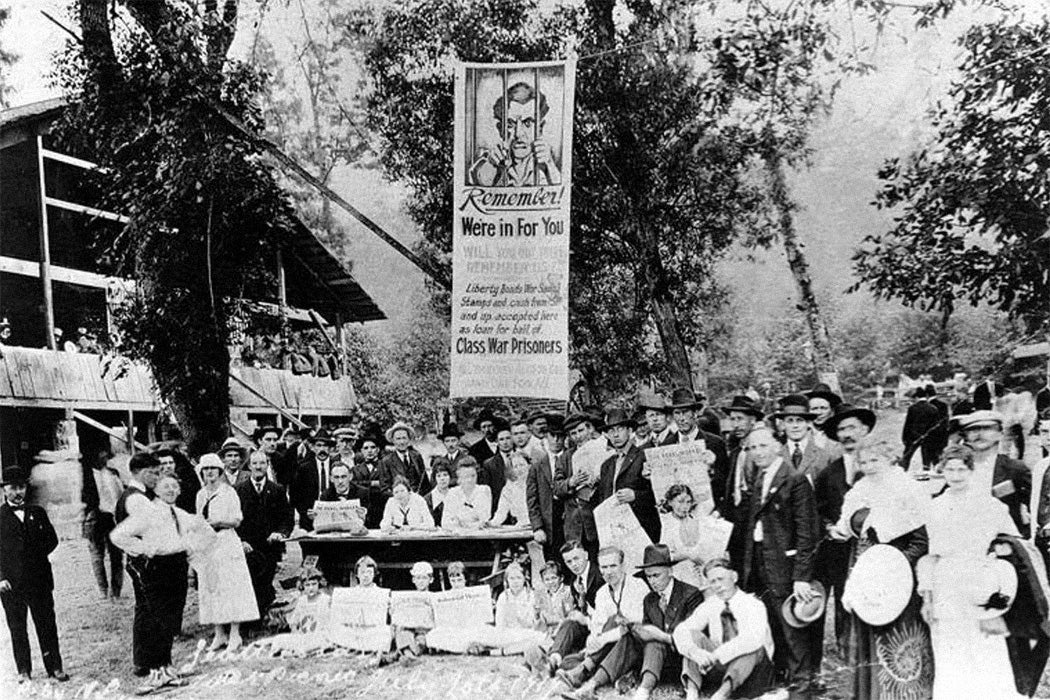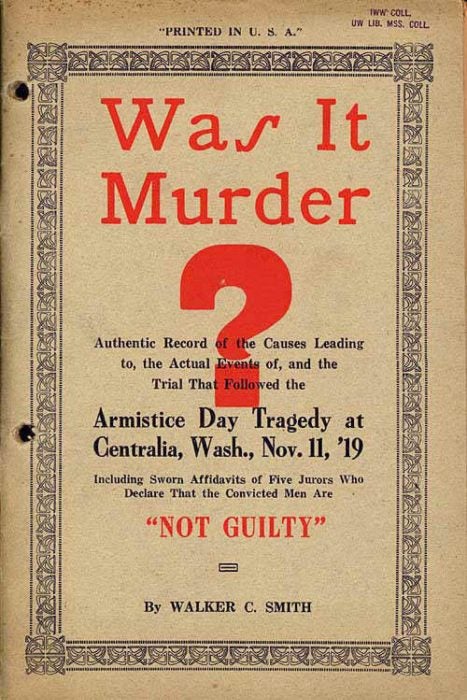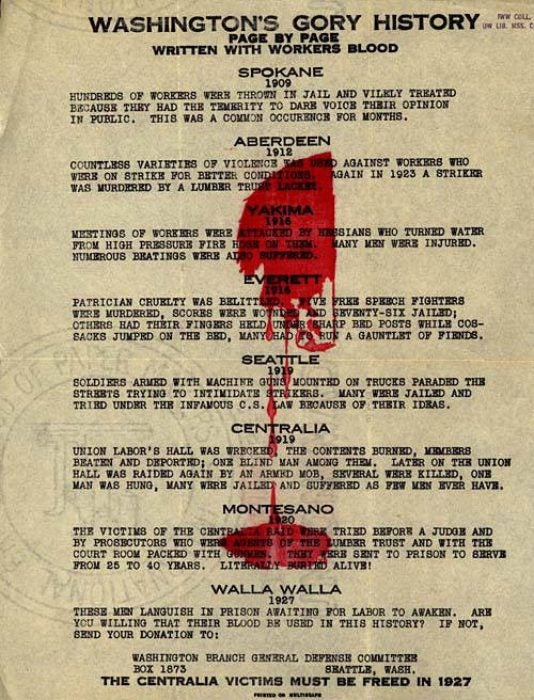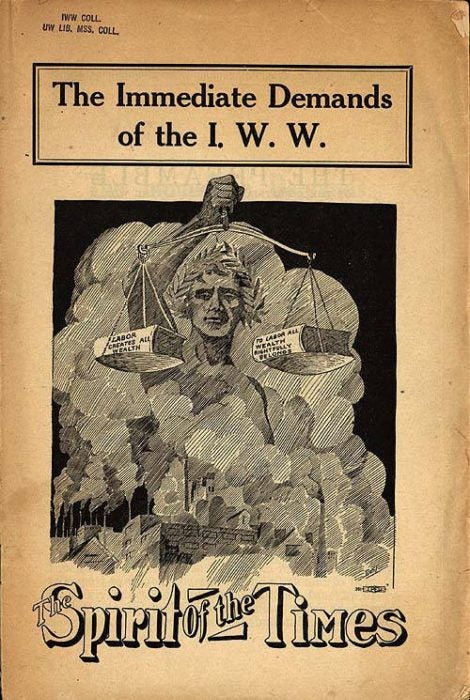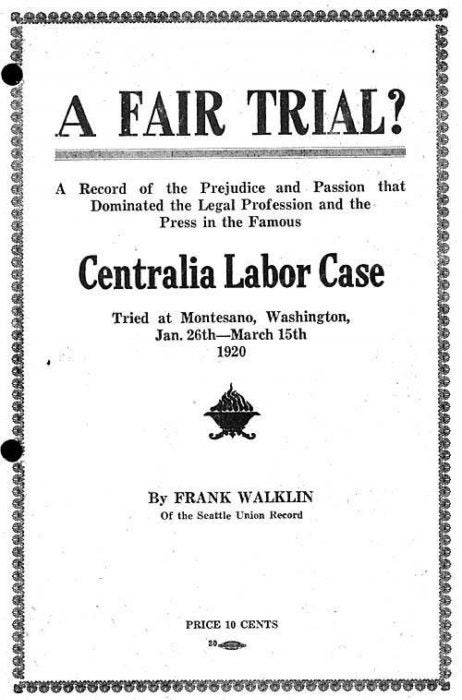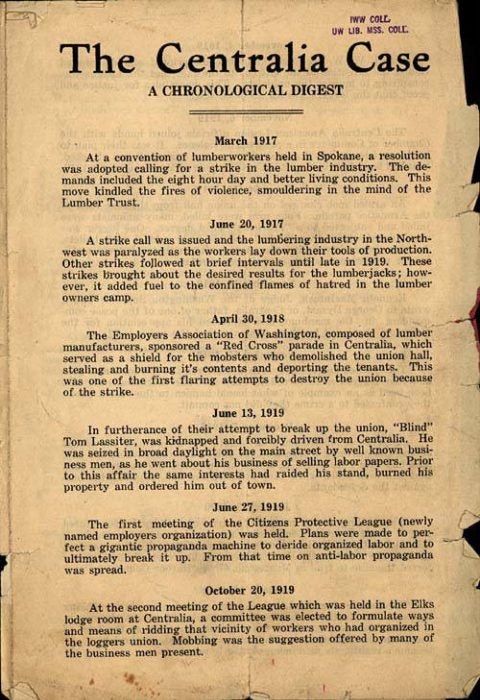On November 11, 1919, tensions came to a head between members of the Industrial Workers of the World (IWW)—known as the Wobblies—and members of the American Legion in Centralia, Washington, at the first Armistice Day parade after World War I. The conflict between the two groups was deep-seated. The American Legion had been chartered as a patriotic veteran’s organization just after the war. Meanwhile, the IWW had opposed U.S. participation; it was the only American labor organization to do so. A fatal confrontation between the two parties began when, as documented in the IWW’s The Centralia Case: A Chronological Digest, “an armed mob charged on the [Wobblies’] union hall from the rear rank of the Armistice Parade.” Legionnaires Warren Grimm, Arthur McElfresh, and Ben Casagranda were killed in the initial blow between the Legionnaires and the Wobblies.
Some Wobblies were able to escape during the violent fight, but the American Legion members initially captured six of the IWW union members, as well as Wesley Everest, who became a martyr to the cause. Tom Copeland explains in The Pacific Northwest Quarterly how the American Legion members “overpowered [Everest], put a belt around his neck, and dragged him back to town.” After beating him with weapons including a spike, the American Legion members—who mistook Everest for Britt Smith, a leading member of the Industrial Workers of the World in the area—lynched him. Legionnaire Dale Hubbard was killed by Everest during his pursuit for the Wobbly. Legionnaires killed John M. Haney, a “deputized” citizen, after misidentifying him as a potential Wobbly, when Haney was searching for Wobblies to arrest. In the end, four American Legion members and an IWW member were killed—three Legion members likely were killed by Wobblies, but the historical record is unclear—during the incident that became known as the Centralia Tragedy. Eleven Wobblies were swiftly arrested and charged for the events that occurred on November 11, but no one was ever arrested for the lynching of Everest.
Weekly Newsletter
More than one hundred years later, accounts still vary about what actually happened that day, with both the Wobblies and the American Legion and their respective supporters claiming that the other side started the conflict. The historian Michael Cohen, writing in the Journal for the Study of Radicalism, for example, reports that before the confrontation, the “Centralia Citizens Protection League and the American Legion had planned a raid on the [Industrial Workers of the World] hall well in advance.” In other words, they deliberately targeted the Wobblies. After the Centralia Tragedy, Washington State permitted the police to arrest members of the Wobblies. Cohen argues that this led to the “repression of radicalism throughout the state and up and down the west coast.”
The Labor Movement on Trial
The day after the Centralia Tragedy, newspapers painted a vile picture of the Wobblies. A November 13, 1919 article in the Eugene Guard described the violent confrontation as a “symptom of impending danger.” The media and the government also stoked xenophobia by claiming that the Wobblies were not Americans. In The Pacific Northwest Quarterly, the historian Donald A. MacPhee explains that “the Wobbly represented at once the disconnected logger of the Northwest woods and the draft-dodging, seditious Bolshevik.” Just like the Bolsheviks, some Americans saw the socialist Wobblies as a threat to the United States. The impending trial was not just a case against the eleven Wobblies, MacPhee argues: It was a case against the labor movement.
On January 26, 1920, the trial against the Wobblies began in Montesano, Washington, overseen by Judge John Wilson. Journalist Frank Walklin of the Seattle Union Record—a union-owned newspaper that was raided by U.S. agents after the Centralia Tragedy—published his first-hand account of the trial in the pamphlet A Fair Trial? Since the trial judge excluded some portion of the Wobblies’ evidence, this pamphlet helped illustrate why the Wobblies’ believed that the Centralia tragedy and its aftermath was a conspiracy against the labor movement.

Walklin argued that the selection of the jury was one of many reasons why he became “convinced that the state attorneys did not want a fair trial.” According to Walklin, “Judge Wilson permitted Thomas Connor to remain on the jury after he had sworn he hated the I.W.W.” Judge Wilson also backtracked on his claim that the trial should be moved from Montesano, Washington— “the County most notoriously prejudiced against the I.W.W.”—after a mere two days.
Michael Cohen documents that prejudice, explaining that the trial featured “an armed encampment of American Legion and state militia members to intimidate the jury.” Moreover, Judge Wilson “gave a eulogy for the slain Legionnaires at their funerals.”—both of which hurt the plight of the Wobblies.
Throughout the trial, the evidence presented by George F. Vanderveer, the defense counsel for the Wobblies, was dismissed. The Los Angeles Times reported on March 7 that Vanderveer “offered proof relative to an alleged conspiracy in Centralia” and “to the lynching of Wesley Everest,” but Judge Wilson refused to let the jury hear Vanderveer’s claims. Vanderveer became so infuriated with Wilson that, according to Walklin, he said the following in court: “There was a time when I thought your honor’s rulings were due to the mere ignorance of the law. However, this will no longer explain them.”
After nearly twenty-four hours of deliberation, the jury found seven of the members of the IWW guilty of second-degree murder, one member not guilty by reason of insanity, and acquitted two members on March 13. In early April, Judge Wilson sentenced the convicted men to 25 to 40 years in prison. According to an IWW Chronological Digest of the case, this happened “despite the jury’s plea for leniency.”
MacPhee explains in The Pacific Northwest Quarterly the “final, violent chapter… of the IWW in the Pacific Northwest… along with the Sacco-Vanzetti case and the Wall Street bombing” helped fuel the first Red Scare. To grasp the extent of the U.S. government’s attempts to finish the IWW and the labor movement, it is important to know the IWW’s history.
* * *
Since the birth of the IWW in 1905, the labor union and the United States government have been in vigorous disagreement which each other. The historian Michael R. Johnson explains that the Wobblies believed “the United States Constitution was a bourgeois fraud which deluded workers into believing that they had influence in government.” In order words, the Wobblies viewed the capitalist system in the United States as the antithesis to workers’ rights. In 1915, U.S. President Woodrow Wilson, seeing the IWW’s power and influence rising, started to crack down on the Wobblies, giving the following speech in front of Congress on the subject of the IWW:
The gravest threats against our national peace and safety have been uttered within our own borders. There are citizens of the United States, I blush to admit, born under other flags but welcomed by our generous naturalization laws to the full freedom and opportunity of America, who have poured the poison of disloyalty into the very arteries of our national life.
Wanting to gain the approval of President Wilson, Johnson explains how lieutenants “quickly perceived that the federal prosecution of the IWW would satisfy influential lobbyists” and help them climb the ranks in the Justice Department. In August 1917, governors from Oregon, Washington, Nevada, Montana, and Idaho also gathered to find a way to work with the federal government to suppress IWW efforts.
While President Wilson encouraged the federal government to crack down on the IWW, local law enforcement and vigilantes did as well. Violence towards Wobblies was not out of the question. Cohen explains in the Journal for the Study of Radicalism that law enforcement and others in Everett, Washington, “attacked a boat full of singing Wobblies, killing up to a dozen people” in November 1916. Less than a year later, two thousand vigilantes forced 1,200 Wobblies in Bisbee, Arizona “onto cattle cars and ‘deported’ to the middle of the New Mexico desert,” allegedly acting in collusion with mining company officials. Despite President Wilson’s, the federal and local governments’, and law enforcements’ attempts to quash the IWW, the Wobblies were not going to go down easily.
Across Washington and the rest of the northwest, Wobblies continued to organize for their rights. Starting on June 20, 1917, a strike in the northwest led the lumber industry to be “paralyzed as the workers lay down their tools of production.” The IWW chronological digest of the Centralia case reports that the strikes continued until late 1919, which was around the time of the Centralia Tragedy.
* * *
While the Centralia Tragedy impacted the image of the IWW, the Wobblies continued to grow. According to a 1967 Radical American article by Fred Thompson, the circulation of the labor union later peaked at 58,300 paid members in 1923, after the Centralia Tragedy. IWW has also organized in Canada, Europe, Africa, and Australia. The IWW also continued to be active in Washington state, as seen by this 1924 meeting photo at Eagles Auditorium Building in Seattle, Washington.
The Wobblies continued to fight for the seven IWW members who were incarcerated after the Centralia Tragedy. Copeland explains in Pacific Northwest Quarterly that the Wobblies published articles, poems, and pamphlets in Wesley Everest’s memory “as part of a growing campaign to urge the release of Everest’s comrades.” It would take ten years for the incarcerated Wobblies to start to be freed.
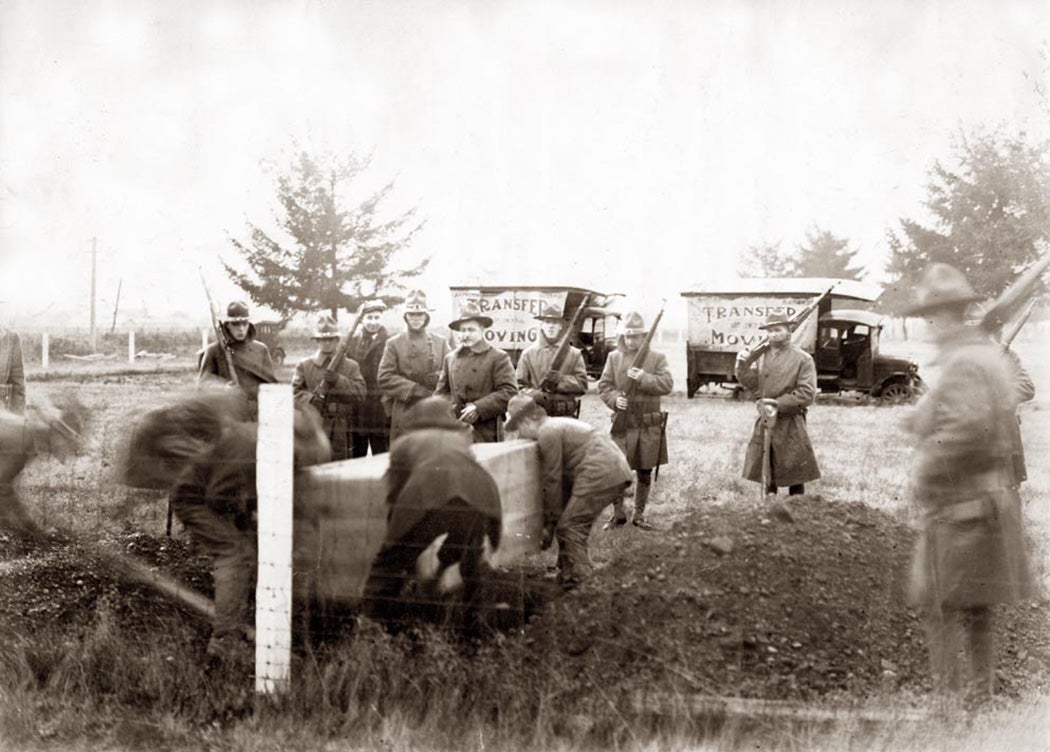
Cohen explains in the Journal for the Study of Radicalism that the “IWW’s General Defense Committee, the Centralia Publicity Committee, and the newly formed American Civil Liberties Union immediately took up a legal defense campaign.” One Wobbly, James McInerney, died in prison in 1930, and two were released in 1931. Washington state’s then-new Governor Clarence Martin offered to parole to the remaining Wobblies, but one—Ray Becker—refused on the grounds that he wanted more than parole, he wanted “it publicly admitted that his imprisonment was fundamentally wrong,” according to an essay published in University of Washington. Becker’s sentence was ultimately commuted in 1939.
November 11, 2019, marked the 100th anniversary of the Centralia tragedy, which the IWW commemorated. IWW Whatcom-Skagit Branch member David Tucker, who goes by Dave, a retired roof maintenance worker who served the IWW as Secretary in 1983, told me that despite there being no organized IWW presence in Centralia since in 1919, “there is a distinct split between those who still hate the IWW” and “those who are ashamed of the town’s history.”
The Wobblies are still attempting to get Centralia, Washington, to recognize and pay tribute to Wesley Everest. While their proposals to get a public memorial for Everest have failed so far, Wobblies have taken it upon themselves to take care of Everest’s grave. Last year on the anniversary of the Centralia tragedy, the Wobblies had three people on the lookout to watch for “possible trouble.” “When Wobs go to the Wesley Everest or other Wobbly gravesites in town for clean up or commemoration, we are on our guard,” Dave said.
As a growing number of people are unemployed or underemployed during the coronavirus pandemic, the approval rating of unions continues to grow, reaching 65 percent in September 2020, according to Gallup. Only time will tell if more people join unions like the IWW, and it may depend on whether they believe in the statements found in Immediate Demands of the I.W.W.: “there can be no peace so long as hunger and want are found among millions of working people and the few, who make up the employing class, have all the good things of life.”
